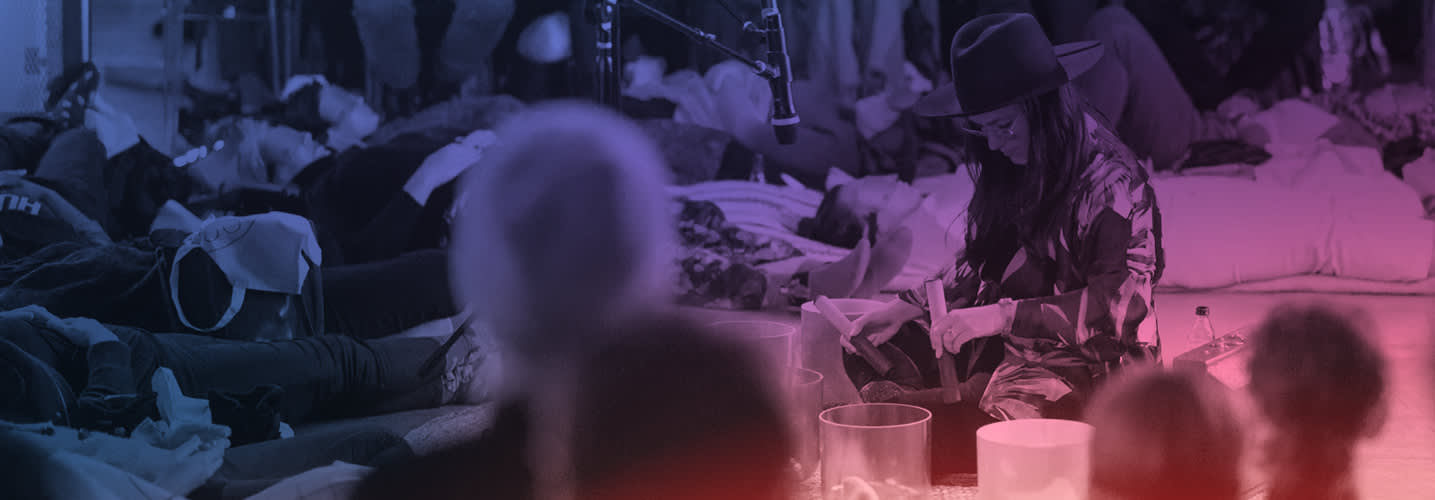Heather Vaughn was 19 when she was diagnosed with Type 1 diabetes, a development that altered her life — sometimes dreadfully. Within six months of her diagnosis, the Arizona native developed crippling panic attacks.
“I no longer trusted my body,” says Vaughn, now 25. “I was scared of everything medical, anything health related: doctor’s visits, needles. I had to drop out of college multiple times.” She said it got to the point where it was hard to even leave the house.
Diagnosed with an anxiety disorder, Vaughn found relief in something medicine has no clear understanding of at all: ASMR videos. “My sister heard that ASMR helped people with anxiety, so she brought it up to me,” she says. The verdict? “Very relaxing.”
The feeling itself is a warm and relaxing wash that can spread down the spine and limbs. In some quarters, ASMR fans call it a “headgasm.”
ASMR, which stands for Autonomous Sensory Median Response, is a phenomenon that has only recently been given a name, in part because it is an intensely personal sensation. ASMR is described by those who experience it as a pleasurably strange tingling feeling, usually felt at the back of the head or scalp. It is caused by certain sounds — close whispering, a crinkling of a candy wrapper, the soft taps on a keyboard — or sights. The feeling itself is a warm and relaxing wash that can spread down the spine and limbs. In some quarters, ASMR fans call it a “headgasm.”
The phenomenon gained widespread attention in the past five or six years, due to a gigantic YouTube subculture that creates ASMR-triggering videos for each other. Videos most often include close-ups of pretty young women making breathy, clicking, whispering, tapping, or crinkling sounds. There are role-playing videos in which the video makers pretend to be hairdressers or doctors or makeup artists, all interacting with the viewer.
Top ASMR YouTubers include a woman named Maria, whose site, GentleWhispering, has more than 600,000 subscribers; Heather Feather and ASMRrequests both have nearly 400,000. Their videos can net upwards of 3 million views.
Yet mainstream recognition tends to brush ASMR aside as weird — a harmless internet freak show — without addressing how many people find ASMR beneficial. BuzzFeed, for example, recently created “ASMR News Now,” a live video of people whispering the news. It’s a gentle piece of mockery created by the viral site’s humor writers who say their aim is “keeping it weird.”
What is happening at a biological level, though, is a mystery.
But YouTube’s tingle masters say their work is all about keeping people well. Many say ASMR has helped them, and that, in turn, has motivated them to make videos for others. GentleWhispering’s Maria (who declined our request for an interview) told the Washington Post she started watching the videos in 2009 to combat insomnia and depression; Kimberley Tregidgo, who creates videos in the U.K., credits ASMR with helping her through post-traumatic stress disorder.
Vaughn herself has been making ASMR videos for the past 18 months under the handle jellybeannose, which has more than 200,000 followers. Her most popular clip currently has more than 2 million views. In it, Vaughn, who is quite pretty, breathes softly into a microphone and makes gentle kissing and popping sounds with her mouth for 30 minutes. To the uninitiated, ASMR videos are strange and vaguely fetishistic-seeming, but practitioners overwhelmingly assert that ASMR is not a kink so much as it is a profound feeling of relaxation
What is happening at a biological level, though, is a mystery. The scientific community has all but completely ignored ASMR until just last year.
So far, only one research paper has been published on the phenomenon. “Autonomous Sensory Meridian Response (ASMR): a flow-like mental state,” by graduate student Emma L. Barratt and lecturer Nick J. Davis at Swansea University in the U.K., only just begins to scratch the surface of understanding. “‘ASMR’ was recently coined as a term after massive communities came together to appreciate it on YouTube,” says Barratt. “It gave everyone a sort of umbrella term, which we’re now looking to explore and refine a definition for.” Her study with Davis asked a series of questions of people who watch ASMR videos, whether there are any predominant triggers among people who claim to experience it, as well as whether it has any effects on mood.
“Specific things such as whispering, crisp sounds (like tinfoil), and close personal attention are extremely common triggers of ASMR,” says Barratt. “People typically use ASMR to achieve relaxation or reduce anxiety. People having issues with mood disorders or chronic pain actually reported that they find significantly more relief through engaging in ASMR than typical individuals did.”
Barratt says she is “keen to understand” the mechanisms that make ASMR so soothing to anxiety sufferers. But as for what is happening at a physiological level, science is still in the dark.
“We don’t know what’s happening in the brain,” says Giulia Poerio, a Ph.D. student at the University of Sheffield, also in the U.K. Poerio, who herself experiences ASMR, is one of four postgraduate students there currently studying what happens to people who say their ASMR is triggered. “We got some people in a lab and hooked them up for physical measurements — heart rate, breathing — while they watched videos we’d give them and ones they self-selected.” They then ran the same tests on people who claim not to have ASMR, to see if there was a difference in vitals.

Poerio says she is excited about her findings but cannot discuss them for months, until the paper her team is writing has been submitted in June and goes through peer review. In the meantime, it’s worth having a look inside the ear.
“How our auditory system and brain processes sound is quite complex,” says Christopher Spankovich, a clinical audiologist at the University of Mississippi Medical Center who says he recently came across the topic of ASMR, but could only speculate on the neurophysiology behind it. The true hearing part of the ear is the cochlea, that little coiled structure inside of it. But it’s not the only part of the ear that receives sound. “Sound can actually stimulate the part of the inner ear that has pathways that go to oculomotor function, the cerebellum, spinal function, and to areas of underlying autonomic reflexes” (such as nausea, sweating, and vomiting), he says.
Basically, as sound reaches the auditory complex within the ear, it communicates with a large network of brain regions — the prefrontal cortex and limbic system (which includes the hippocampus and amygdala), among others. “This brain network allows us to associate meaning and memory with sound, relevance, and emotion, including activation of autonomic functions,” he says. “It is likely these higher regions that are associated with stress response are underlying the physiological reaction [of ASMR]. These also happen to be areas we have the least knowledge of.”
The scientific community tends to be slow to dig deeply into phenomena that can be dismissed as fringe.
But science may not solve this mystery anytime soon: the scientific community tends to be slow to dig deeply into phenomena that can be dismissed as fringe. Meditation, for example, has been practiced by humans for millennia. But its healing and palliative potential has only been subjected to rigorous study in the past generation or so.
“Meditation was first introduced in the U.S. as part of the hippie drug culture in the ’60s, along with crystals and other New Age fads. So it was lumped in with these fringe practices and mostly practiced by people who were not taken seriously, and so any claimed benefits were discounted,” says Sara Lazar of the Massachusetts General Hospital Psychiatric Neuroimaging Research Program.
In 2014, Lazar, a Harvard Medical School instructor in psychology, led a team of researchers on the very first study to document what changes meditation produces over time in the brain’s gray matter. It turns out meditation can actually rebuild gray matter. And yet it took decades for the medical field to believe practitioners’ claims that meditation helps them.
“In the ’90s it started getting associated with the health culture, and then several mental health providers began doing some respectable studies on the clinical benefits, then it has gradually taken off from there,” Lazar says.
ASMR researches are hoping their first-of-its-kind study will bring some credence to claims that something happens to the bodies of people under ASMR’s sway. Poerio says she’s experienced it her whole life, but didn’t realize other people get it, too. “I thought it was a nice thing I got when some people talk,” she says. ”Then I found out it was a thing, that there was this whole YouTube community.”
She wonders if it may be related to synesthesia, the triggering of a sensation in one part of the body by stimulating a different part of the body. But because it’s not a universal phenomenon, she says, the scientific community didn’t have a clear incentive or mandate to look into it until now.
Only 5 percent of the participants reported using ASMR for sexual stimulation, while 82 percent said they used ASMR to help them sleep, and 70 percent said ASMR helped them deal with stress.
To an outsider, ASMR videos can seem a bit outré, unusual, or startling. “The mainstream media makes ASMR out to be more ‘weird’ than ‘sexual.’ Or sometimes both at the same time,” says Vaughn. “When people who don’t watch it on the regular see it for the first time, I can understand how it would seem sexual or weird. But we all just kind of brush it off at this point.” Indeed, in the study conducted by Davis and Barratt at Swansea, only 5 percent of the participants reported using ASMR for sexual stimulation, while 82 percent said they used ASMR to help them sleep, and 70 percent said ASMR helped them deal with stress.
Vaughn says she is eager to hear the results of the Sheffield study. She believes understanding what was happening in the brains of her fans would have a direct effect on the content she makes. “I’m not sure how, but it would,” she says.
For her part, Sheffield’s Poerio has a personal interest in her study’s results. “I watch ASMR videos and I would say that I am part of the ASMR community,” she says. “They tend to be quite supportive.”
Poerio counts herself a fan of Maria “GentleWhispering.” She particularly enjoys this video, in which Maria gives a man a forearm massage. The triggers for her, she says, are Maria’s voice and accent, her hand movements, and the instructional element of the video.
“People creating content for other people to relax to? It’s nice of people to do.”




